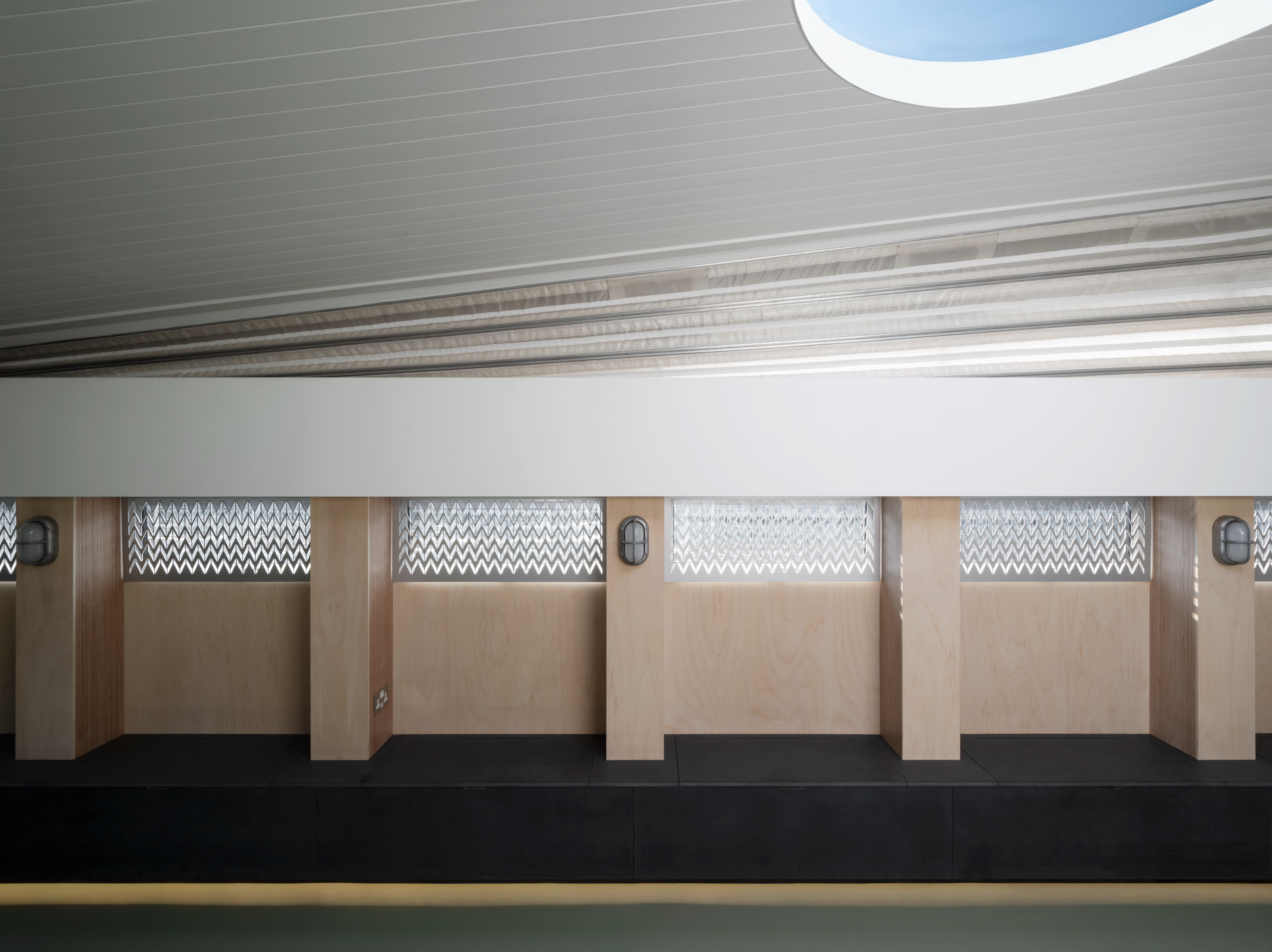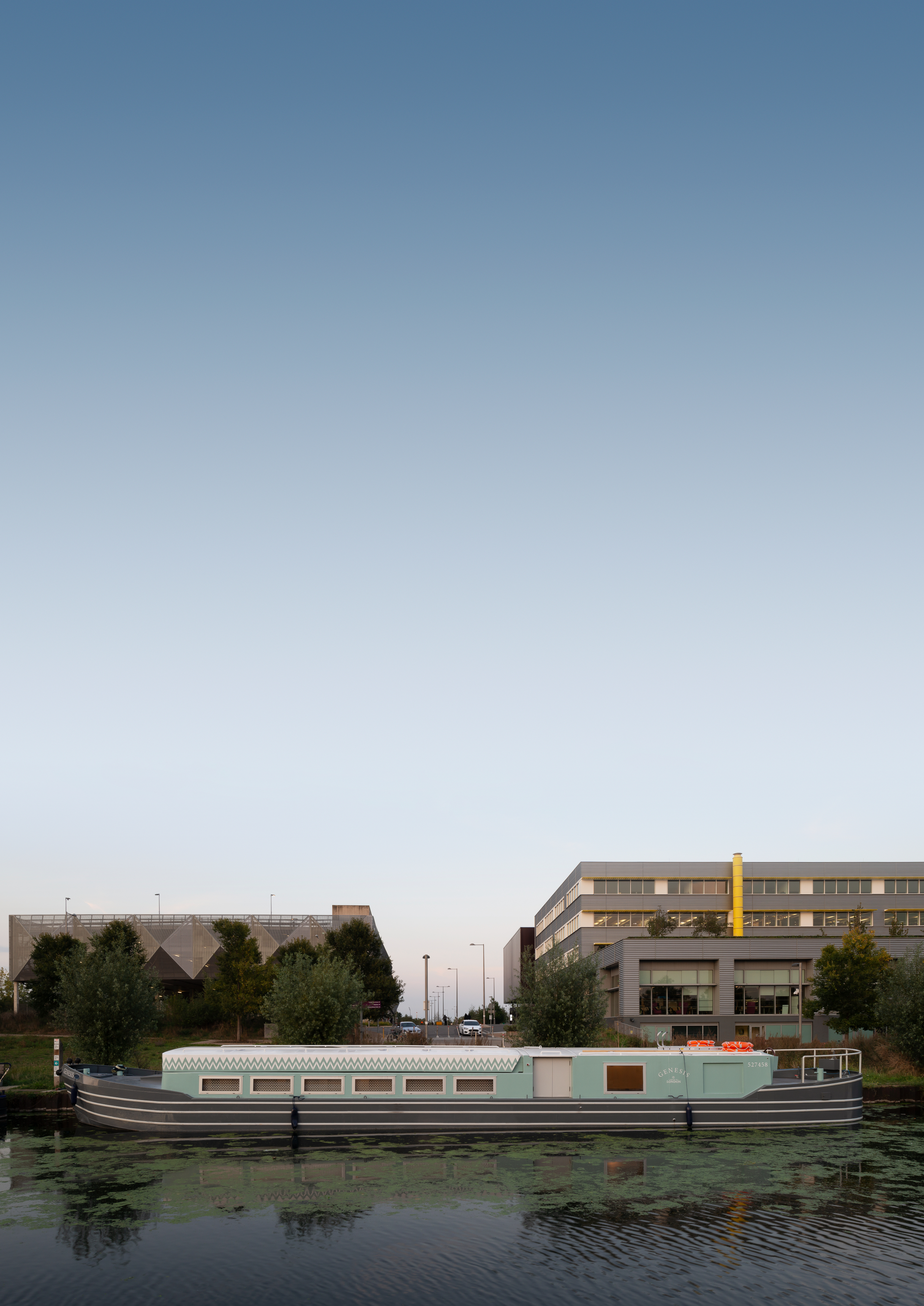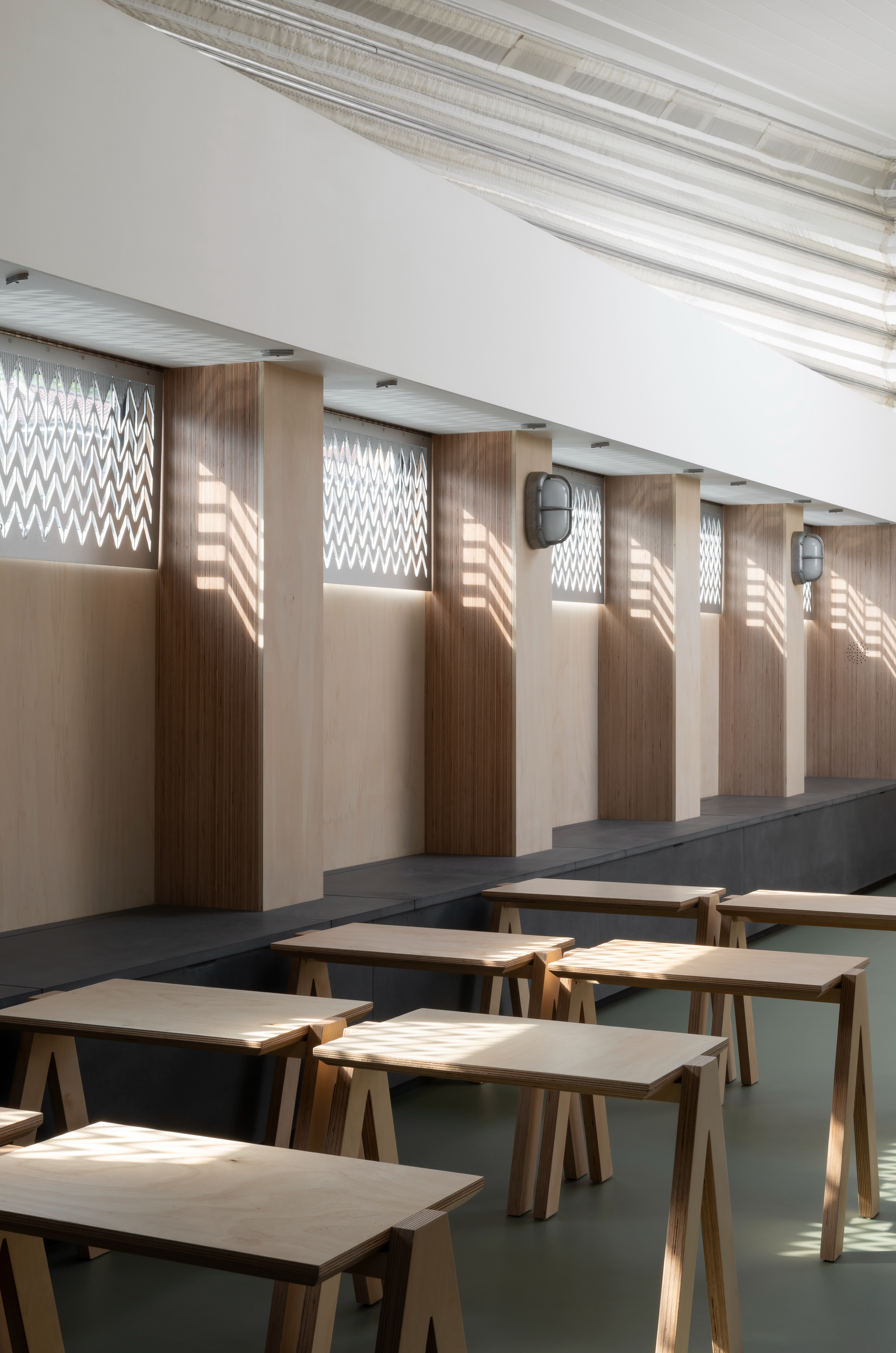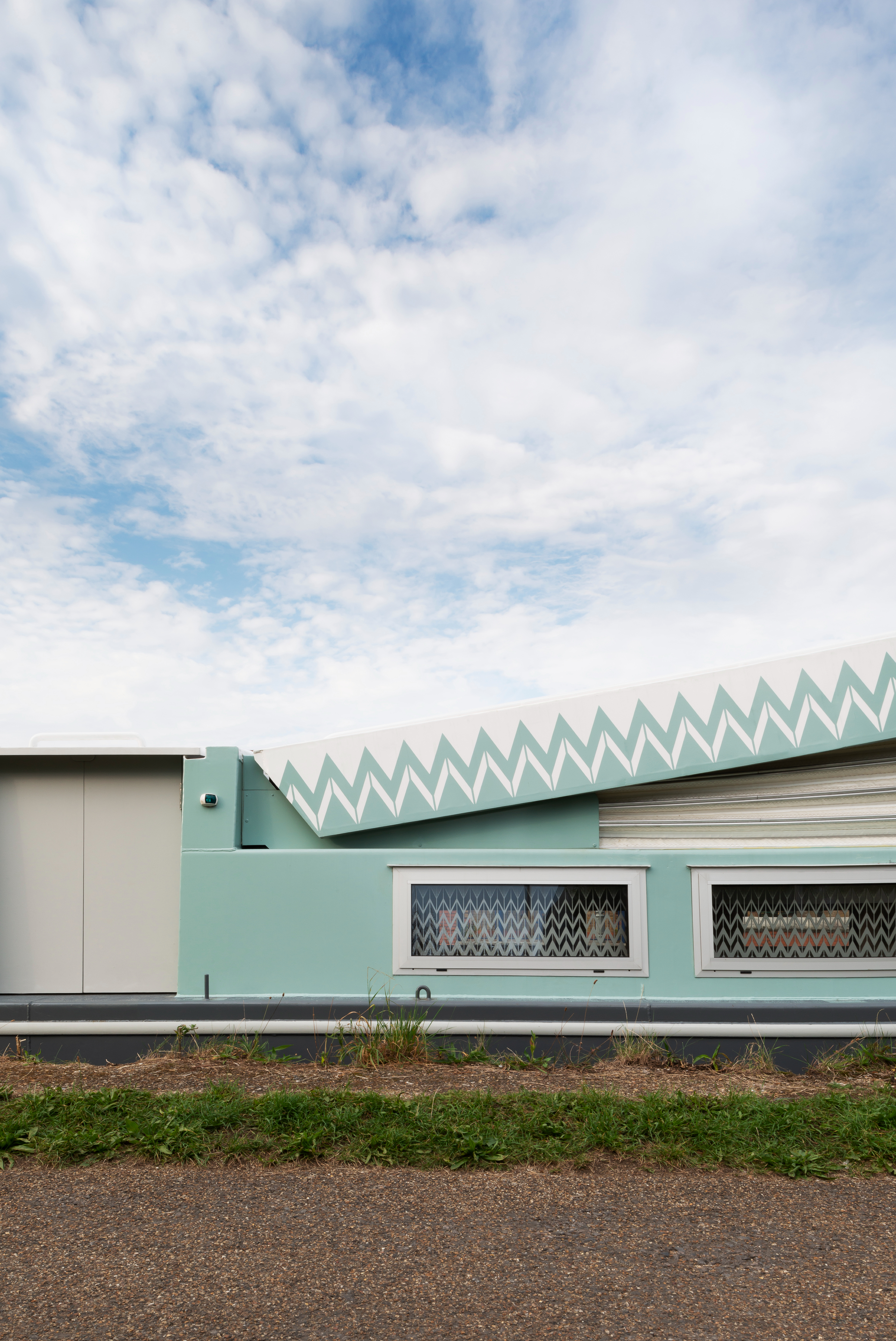A floating church has moored in East London
Architecture studio Denizen Works has completed Genesis Floating Church – an innovative religious and community space for the Diocese of London
Gilbert McCarragher - Photography

A floating church has moored in East London. The work of locally-based architecture studio Denizen Works, this innovative project brings together architecture and boat building, religious, community spaces and practice, and contemporary design.
The project was spearheaded by the Diocese of London for the St Columba East London community, and has been created in close collaboration with Turks Shipyard and naval architect Tony Tucker. Now floating on the River Lee Navigation alongside Here East at Queen Elizabeth Olympic Park, the scheme aims to become a beacon for local communities and a space to, not just pray, but also meet, gather and plan a range of activities in. As well as serving as a space for a church, the barge can accommodate, for example, parent and toddler groups, pilates classes and art classes, interfaith celebrations, lunch and supper clubs, live music, employment training, support workshops and counselling.
‘We wanted to develop a design which would transform in shape to be delightful and surprising to answer the client brief to create a ‘conspicuous presence’ on the towpaths of London,' explains Denizen Works director Andrew Ingham. ‘Like all of our projects, we looked widely for inspiration and the trigger often comes from unexpected places. We drew inspiration from architecture that transforms as well as other spaces, including the classic VW camper van. The notion of the reconfiguration of spatial experience through mechanics felt right but we also wanted it to link back more directly to ecclesiastical heritage and through our research of church buildings through the ages we came across some beautiful woodprints of organ bellows. We were particularly taken with the sculptural form of these bellows and we wanted our roof to share this formal quality whilst establishing a subtle poetic link to traditional churches.'

Architecturally, the design's centrepiece is its unique, organ bellow-inspired kinetic roof. Created in translucent sailcloth, lined with LED lights and powered by hydraulic rams, it can expand and contract and adapt to the space's needs. It can be easily operated by the touch of a button.
‘Mobile architecture, particularly on boats, has a rich history and we looked at Rossi’s Teatro del Mondo and more directly Kahn’s floating theatre, which like the church transforms in use,' says Denizen Works director Murray Kerr. ‘Our approach to the interior was to create a gallery space, free from religious symbolism, so that it would be welcoming to all, to align with the wider community uses planned for the boat. There are subtle references in the plan to elements of church architecture including the nave and aisles, but for the most part we have allowed the boat to be a boat within which we have inserted a beautiful room.'
Upon entering, midship, one side - the front - contains the main hall for about 40-60 people (depending on the configuration and circumstances) with its plywood walls, green linoleum floor and round skylight; while services, such as kitchen and bathrooms are located on the opposite end of the barge. Flexible, custom made furniture, has been delivered by local design company Plyco.
Named Genesis, after the first book of the Bible, the project ‘alludes to the narrative of creation,' explains the team behind it, which includes Rev Dave Pilkington, who will lead the new church's activities. ‘Having an amazing space, that is beautiful, peaceful and offers hospitality in an unusual place in a creative and surprising way tells a similar story,' he adds. ‘It’s good news and it is found where people might not expect to find it. That is disruptive in a gentle way, it can challenge people's view of what Church can be and hopefully at least opens them to have a conversation about life and spirituality. It is also an intimate space which does not overwhelm or make you feel small and insignificant. I hope it becomes a place where people can feel like they have a seat at the table, a place where they can belong, as they get to know other people.'
The structure is set to remain on this spot for three to five years, reaching out and supporting communities living around the East London canal.






INFORMATION
Receive our daily digest of inspiration, escapism and design stories from around the world direct to your inbox.
Ellie Stathaki is the Architecture & Environment Director at Wallpaper*. She trained as an architect at the Aristotle University of Thessaloniki in Greece and studied architectural history at the Bartlett in London. Now an established journalist, she has been a member of the Wallpaper* team since 2006, visiting buildings across the globe and interviewing leading architects such as Tadao Ando and Rem Koolhaas. Ellie has also taken part in judging panels, moderated events, curated shows and contributed in books, such as The Contemporary House (Thames & Hudson, 2018), Glenn Sestig Architecture Diary (2020) and House London (2022).
-
 Terrified to get inked? This inviting Brooklyn tattoo parlour is for people who are 'a little bit nervous'
Terrified to get inked? This inviting Brooklyn tattoo parlour is for people who are 'a little bit nervous'With minty-green walls and an option to 'call mom', Tiny Zaps' Williamsburg location was designed to tame jitters
-
 Let’s hear it for the Chopard L.U.C Grand Strike chiming watch
Let’s hear it for the Chopard L.U.C Grand Strike chiming watchThe Swiss watchmaker’s most complicated timepiece to date features an innovative approach to producing a crystal-clear sound
-
 Form... and flavour? The best design-led restaurant debuts of 2025
Form... and flavour? The best design-led restaurant debuts of 2025A Wallpaper* edit of the restaurant interiors that shaped how we ate, gathered and lingered this year
-
 Arbour House is a north London home that lies low but punches high
Arbour House is a north London home that lies low but punches highArbour House by Andrei Saltykov is a low-lying Crouch End home with a striking roof structure that sets it apart
-
 A former agricultural building is transformed into a minimal rural home by Bindloss Dawes
A former agricultural building is transformed into a minimal rural home by Bindloss DawesZero-carbon design meets adaptive re-use in the Tractor Shed, a stripped-back house in a country village by Somerset architects Bindloss Dawes
-
 RIBA House of the Year 2025 is a ‘rare mixture of sensitivity and boldness’
RIBA House of the Year 2025 is a ‘rare mixture of sensitivity and boldness’Topping the list of seven shortlisted homes, Izat Arundell’s Hebridean self-build – named Caochan na Creige – is announced as the RIBA House of the Year 2025
-
 In addition to brutalist buildings, Alison Smithson designed some of the most creative Christmas cards we've seen
In addition to brutalist buildings, Alison Smithson designed some of the most creative Christmas cards we've seenThe architect’s collection of season’s greetings is on show at the Roca London Gallery, just in time for the holidays
-
 In South Wales, a remote coastal farmhouse flaunts its modern revamp, primed for hosting
In South Wales, a remote coastal farmhouse flaunts its modern revamp, primed for hostingA farmhouse perched on the Gower Peninsula, Delfyd Farm reveals its ground-floor refresh by architecture studio Rural Office, which created a cosy home with breathtaking views
-
 A revived public space in Aberdeen is named Scotland’s building of the year
A revived public space in Aberdeen is named Scotland’s building of the yearAberdeen's Union Terrace Gardens by Stallan-Brand Architecture + Design and LDA Design wins the 2025 Andrew Doolan Best Building in Scotland Award
-
 The Architecture Edit: Wallpaper’s houses of the month
The Architecture Edit: Wallpaper’s houses of the monthFrom wineries-turned-music studios to fire-resistant holiday homes, these are the properties that have most impressed the Wallpaper* editors this month
-
 A refreshed 1950s apartment in East London allows for moments of discovery
A refreshed 1950s apartment in East London allows for moments of discoveryWith this 1950s apartment redesign, London-based architects Studio Naama wanted to create a residence which reflects the fun and individual nature of the clients